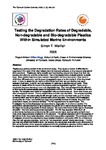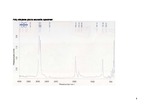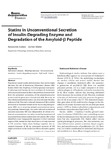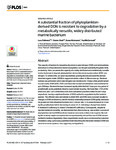Testing the Degradation Rates of Degradable, Non-degradable and Bio-degradable Plastics Within Simulated Marine Environments
| dc.contributor.author | Wellfair, S. | |
| dc.date.accessioned | 2019-05-10T10:40:09Z | |
| dc.date.available | 2019-05-10T10:40:09Z | |
| dc.date.issued | 2008 | |
| dc.identifier.citation |
Wellfair, S. (2008) 'Testing the Degradation Rates of Degradable, Non-degradable and Bio-degradable Plastics Within Simulated Marine Environments', The Plymouth Student Scientist, 1(2), pp. 243-301. | en_US |
| dc.identifier.issn | 1754-2383 | |
| dc.identifier.uri | http://hdl.handle.net/10026.1/13816 | |
| dc.description | Plastics are a serious problem in the environment today. They cause a number of difficulties for organisms in the water which often mistake them for food and suffocate, or they become entangled in them and drown. Plastics are highly versatile and hard wearing, they survive longer than their use requires and often end up in the environment. One of the largest forms of plastic pollution is plastic bags. Many plastics bags have been deemed ‘degradable’ and have been given a time frame in which they will break down, but this does not suggest the type of environments in which they break down. In order to asses this, six marine environments have been set up including mud, sand, saltwater, freshwater, buried in mud and saltwater in darkness to simulate deeper water. Three samples of plastic will be the focus of the project, a claimed degradable bag from Tesco, a non-degradable bag from Sainsbury’s and a bio-degradable bag. They were all placed into the different environments and systematically tested for degradation every three months. The project ran for nine months. The samples were tested for degradation using several techniques. There were ‘before and after’ photographic records. The dry weight before and after was also taken. The samples capability to withstand load was tested using tensile strength testing and the chemical make up of the bonds contained within was found using a process called photo-acoustics. The result of the investigation showed that the Tesco, and Sainsbury’s bags were practically identical chemically, they were both polyethylene based, and behaved similarly. The Bio-bag seemed to be starch based. The investigation found that all samples had succumbed to degradation in one form or another. The polyethylene samples deprived of light degraded very slowly and it was concluded that UV light was the trigger for causing degradation in these samples. The best environment for this was the freshwater simulation. Mud and sand caused least degradation. The Bio-bag degraded efficiently in all environments, but favoured environments with a more anoxic nature, such as being buried in mud. Here, there was a complete breakdown of the structure. The sample degraded even in the absence of light shown in the deep water simulation, where there was positive degradation. The conclusion of the investigation showed that polyethylene based plastics breakdown very poorly within the environment. Also that both samples degraded, but that the ‘non-degradable sample’ simply takes longer. The Bio-bag was very efficient at breaking down, but became very structurally weak after a very short period of time and is therefore not an adequate replacement for the polyethylene samples, further evidence that bio-degradable samples could be manipulated to eventually replace plastic as we know it. | en_US |
| dc.language.iso | en | en_US |
| dc.publisher | University of Plymouth | |
| dc.rights | Attribution 3.0 United States | * |
| dc.rights.uri | http://creativecommons.org/licenses/by/3.0/us/ | * |
| dc.subject | degradable | en_US |
| dc.subject | non-degradable | en_US |
| dc.subject | marine | en_US |
| dc.subject | marine environment | en_US |
| dc.subject | plastics | en_US |
| dc.subject | plastic | en_US |
| dc.subject | suffocate | en_US |
| dc.subject | break down | en_US |
| dc.subject | environment | en_US |
| dc.subject | environmental | en_US |
| dc.subject | polyethylene | en_US |
| dc.subject | Bio-bag | en_US |
| dc.subject | bag | en_US |
| dc.title | Testing the Degradation Rates of Degradable, Non-degradable and Bio-degradable Plastics Within Simulated Marine Environments | en_US |
| dc.type | Article | |
| plymouth.issue | 2 | |
| plymouth.volume | 1 | |
| plymouth.journal | The Plymouth Student Scientist |






